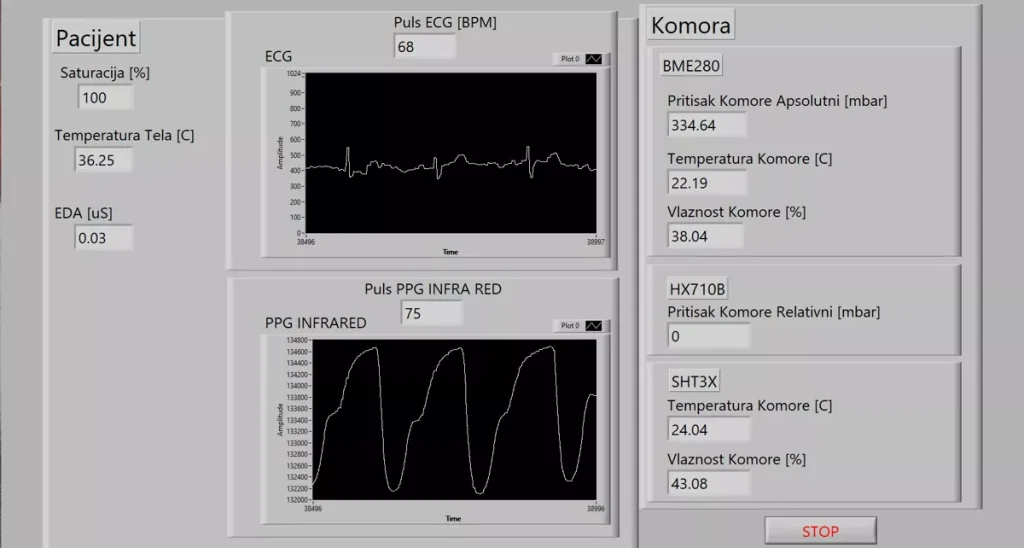It all started in a hyperbaric oxygen chamber.
During his own therapy sessions to treat migraine headaches, Professor Ivan Pavlović began to notice something that most patients never see. Behind the sealed glass of the chamber, doctors and nurses were stretched thin, constantly monitoring every patient’s vital signs. For those in critical condition, that meant round-the-clock attention. And for patients, it often meant a passive, sometimes uncomfortable experience that many didn’t complete.
Ivan realized the problem wasn’t with the treatment itself. Hyperbaric Oxygen Therapy (HBOT) is well-established in medicine and can help heal wounds, infections, and neurological conditions. The problem was in how it was delivered.
Instead of walking away, he decided to fix it.
Together with his wife, Professor Dragana Pavlović, and a small team of university researchers and engineers, he founded HealthControl, a startup dedicated to modernizing HBOT with smarter tools and better patient experience.
Solving the hidden challenges of HBOT
The team quickly identified the main issues limiting the therapy’s potential.
- Too many patients (sometimes up to 65%) abandon treatment early due to discomfort or a lack of visible progress.
- Medical staff are overworked, with two or three specialists required to monitor each session.
- And both patients and doctors often lack clear, real-time insight into how the therapy is affecting the body.
HealthControl’s answer is OxyControl, a medical device that helps clinics deliver HBOT in a more effective, data-driven way. It monitors the patient’s physiological responses and chamber parameters in real time, enables immediate reaction if adverse reactions occur, and provides doctors with continuous feedback throughout the session.
With this level of precision, patients feel safer and more involved in their therapy. The possibility of out-of-sight therapy monitoring and control reduces doctors’ engagement. Early testing shows that OxyControl could help up to 95% of patients complete their full treatment plan.
Why completing therapy matters
For many patients, especially those with non-healing wounds, consistency can be the difference between recovery and amputation. Studies show that completing the full HBOT protocol leads to a 74–95% healing rate, compared to just 60% when patients stop early, and less than 30% with other treatments.
HealthControl’s goal is to make adherence the norm, not the exception. When patients can see measurable progress and doctors can explain results backed by live data, everyone is more motivated to continue.
From idea to prototype
HealthControl’s technology isn’t just a concept. The team has already developed and tested an advanced prototype, reaching TRL6, meaning it has been validated in both laboratory settings and real clinical environments. They partnered with Intermedic HBO (a leading hyperbaric clinic in Serbia) to refine and test the device.
The collaboration went so well that Intermedic HBO has already agreed to purchase the first three devices once they hit the market. Two major distributors, OxyHealth Balkans and MediSal, have also shown interest in adding OxyControl to their product catalogs.
At the same time, the team is developing an XR-based educational app to train medical staff and educate patients about the benefits of HBOT. The idea is simple: when people understand the process, they’re more likely to complete it.

Recognition and real-world validation
In 2024, HealthControl completed Serbia’s SmartStart program organized by the Innovation Fund, where they gained valuable exposure and early recognition. A year later, the company’s CMO, Professor Dragana Pavlović, was invited to speak at the 67th International Fair of Technics and Technical Achievements, one of the country’s largest innovation events. Her presentation was selected as one of the top four startup showcases at the fair. The Serbian Chamber of Commerce and the Science and Technology Park of Niš support HealthControl’s participation in Web Summit Lisbon 2025.
The team’s patent search confirmed that there’s nothing quite like OxyControl on the global market. It’s a first-of-its-kind medical device for HBOT that merges monitoring, feedback, and efficiency into one system.
The people behind the vision
What makes HealthControl different isn’t just its technology. It’s the people driving it.
Ivan and Dragana met back in high school, studied in different cities, and later found themselves working at the same university. They got married and eventually turned their shared love for science into a mission to make healthcare better. Together, they bring decades of research experience across medicine, mechanics, and education.
They’re joined by Professor Nikola Vitković, head of IT systems at the University of Niš Faculty of Mechanical Engineering, and Professor Milena Rajić, who supports the XR development work. Between them, the team combines more than 80 years of academic expertise — and just as much curiosity.

When asked what drives them, Dragana smiles. “We want to make treatments feel safe, intelligent, and human,” she says. “It’s what medicine should be.”
Where they’re headed next
The path forward is clear. The team plans to finalize certification for OxyControl, adapt the software to meet different clinic needs, and roll out the XR training app to reach a broader audience. Their two target markets (hyperbaric equipment and XR healthcare education) are both growing fast, offering global potential.
But HealthControl’s ambitions reach beyond technology. Their work aligns with the European Green Deal and the UN Sustainable Development Goals by reducing oxygen waste, cutting down on single-use materials, and improving energy efficiency. In their view, smarter healthcare should also mean more sustainable healthcare.
HealthControl is proof that real innovation starts with empathy — seeing a problem from the inside and refusing to accept it as normal.
At Labena Ventures, we’re proud to support their mission to bring intelligence and compassion into one of medicine’s most promising treatments.
Because when patients feel seen, data works harder, and technology truly heals.
